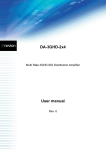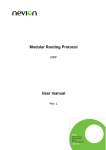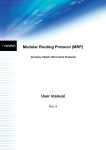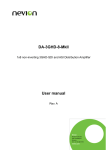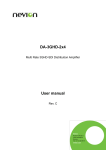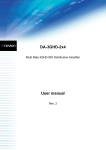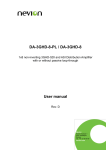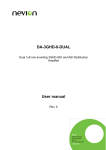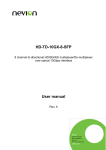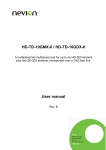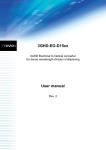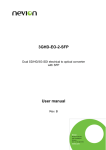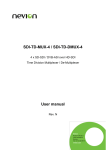Download 3GHD-CHO-2x4/2x3 User manual
Transcript
3GHD-CHO-2x4/2x3 Multi Rate 3GHD-SDI Distribution Amplifier with change-over User manual Rev. D Nevion Nordre Kullerød 1 3241 Sandefjord Norway Tel: +47 33 48 99 99 nevion.com 3GHD-CHO-2x4/2x3 Rev. D Nevion Support Nevion Europe Nevion USA P.O. Box 1020 3204 Sandefjord, Norway Support phone 1: +47 33 48 99 97 Support phone 2: +47 90 60 99 99 1600 Emerson Avenue Oxnard, CA 93033, USA Toll free North America: (866) 515-0811 Outside North America: +1 (805) 247-8560 E-mail: [email protected] See http://www.nevion.com/support/ for service hours for customer support globally. Revision history Current revision of this document is the uppermost in the table below. Rev. Repl. Date Sign D C 2015-06-22 AJM C 2 2014-06-02 2 1 2012-11-19 1 0 2011-09-15 0 - 2011-01-31 Change description VSTD not supported. LNUM only on hardware 1.1 or newer. OEH Added setting where output 2 does opposite of cho MMI Updated cover page and removed Declaration of Conformity. RB Updated table 3 - Description of GPI interface: - GPI “Main/Backup” renamed to “Main”, and it senses main and not selected input. - Changed to focus on outputs rather than inputs for signal present. Specifications for electrical outputs: - Added note regarding output signal level when using passive bypass versions. Specifications for electrical inputs: - Divided the cable equalization @2970Mbps into 2 classes; with and without relays for passive bypass. Product overview: - Added comment of 60 meters of cable equalizing for 2970Mbps with the passive bypass versions. MR/AJM Changed description of VSTD to not be supported on 3G. Added Multicon Gyda status and configuration. MR Initial revision nevion.com | 2 3GHD-CHO-2x4/2x3 Rev. D Contents Revision history .......................................................................................................... 2 1 Product overview ..................................................................................................... 4 2 Variants ................................................................................................................... 5 3 Specifications .......................................................................................................... 6 4 Status by LED’s ....................................................................................................... 7 5 Status and control from GPI .................................................................................... 8 6 Configuration by DIP................................................................................................ 9 6.1 Configuration Examples..................................................................................................10 7 Status from Multicon Gyda .................................................................................... 11 7.1 Label and picture ............................................................................................................11 7.2 Input ...............................................................................................................................11 7.3 GPI .................................................................................................................................11 7.4 Voltage ...........................................................................................................................11 7.5 Reclocker .......................................................................................................................12 7.6 Video analyzer ................................................................................................................12 7.7 Alarms ............................................................................................................................12 8 Configuration from Multicon Gyda ......................................................................... 13 8.1 Card label .......................................................................................................................13 8.2 Firmware upgrade ..........................................................................................................13 8.3 Electrical input ................................................................................................................13 8.4 Reclocker .......................................................................................................................13 8.5 Electrical output ..............................................................................................................13 8.6 Change over block..........................................................................................................14 8.7 Output 2 behaviour when set to CHO .............................................................................15 8.8 Video triggers .................................................................................................................16 8.9 Video analyzers ..............................................................................................................17 9 Alarms on Multicon Gyda....................................................................................... 18 9.1 Electrical input ................................................................................................................18 9.2 Reclocker .......................................................................................................................18 9.3 Change over ...................................................................................................................18 9.4 GPI .................................................................................................................................18 9.5 Voltage ...........................................................................................................................18 10 Information from Multicon Gyda ........................................................................... 19 11 Backplane ............................................................................................................ 20 General environmental requirements for Nevion equipment..................................... 22 Product Warranty ...................................................................................................... 23 Appendix A Materials declaration and recycling information..................................... 24 A.1 Materials declaration ......................................................................................................24 A.2 Recycling information .....................................................................................................24 nevion.com | 3 3GHD-CHO-2x4/2x3 Rev. D 1 Product overview The Flashlink 3GHD-CHO-2x4 is a multi bit-rate distribution amplifier module providing high performance media distribution for various signal formats from 19.4Mbps up to 2970Mbps. The unit can be configured to do cable equalizing and reclocking of SMPTE 424M, SMPTE 292M and SMPTE 259M signal formats. The two inputs typically provide automatic cable equalizing for up to 70 meters (60 meters for the passive bypass versions) of cable (Belden 1694A at 2970Mbps) with a total of 8/6 reclocked outputs. The 3GHD-CHO-2x4 will detect 3GHD, HD and SD rates and automatically switch to the correct output slew-rate. The reclockers support the bit-rates 270Mbps, 1483.5Mbps, 1485Mbps 2967Mbps and 2970Mbps. For other rates, the reclockers automatically switch to bypass mode, and the 3GHD-CHO-2x4 will work as a non-reclocking distribution amplifier with cable equalizers. The 3GHD-CHO-2x4 also supports reclocking of DVB-ASI at 270Mbps, enabling all possible rates including empty transport streams with only K28.5 padding packets. 4 of the outputs are non-inverting and suitable for DVB-ASI. The unit can be configured as a 1 x 8/6 distribution amplifier including any of the input ports. The included intelligent change-over feature gives the ability to change input based on input signal loss, loss of lock, EDH errors or a combination of the above. There is also included a passive bypass function (with backplane board C2 and C4) from both inputs to non-inverted outputs with less than 15 m loss of cable length (enables full redundancy in case of mains failure). The 3GHD-CHO-2x4 is designed for all distribution purposes in studio, duplication and broadcast applications. nevion.com | 4 3GHD-CHO-2x4/2x3 Rev. D 2 Variants The 3GHD-CHO-2x4 main board can be combined with 4 different backplane boards giving functions as follows: Product 19425 19427 19429 19431 G 3GHD-CHO-2x4 3GHD-CHO-2x4-PB 3GHD-CHO-2x3-G 3GHD-CHO-2x3-PB- Type of backplane board Version C1 Version C2 Version C3 Version C4 # Outputs 8 8 6 6 GPI I/O Relay (passive loop-through) No No Yes Yes No Yes No Yes Table 1. Product overview. Please observe that –G versions cannot be used with N-Box, Flashlink one module desktop box, due to mechanical issues. nevion.com | 5 3GHD-CHO-2x4/2x3 Rev. D 3 Specifications Electrical Outputs Connectors Output Return loss Output signal level Output signal rise / fall time 20% - 80% Amplitude overshoot Polarity Output timing jitter Output alignment jitter Electrical Inputs Connectors Input Cable Eq. @270Mbps Input Cable Eq. @1485Mbps Input Cable Eq. @2970Mbps Input Return loss Jitter tolerance Features Reclocking: Supported clock rates: Input equalizers: Supported standards SMPTE: DVB-ASI: General DC power consumption: 75 Ohm BNC - < -15dB, 5MHz -1.5GHz - < -10dB, 1.5GHz - 3GHz 800mV +/- 10% Note: for the passive bypass versions (using backplane C2 or C4) the signal is attenuated with a cable equivalent of 15m. - SD limit: [0.4ns – 1.5ns]; <0.5ns rise/fall var. - HD limit: < 270ps, <100ps rise/fall var. - 3G HD limit: <135ps, <50ps rise/fall var. <10% - Output O1A, O1B, O2A and O2B: Non inverting electrical - Remaining outputs: inverting electrical - SD: <0.2 UI - HD: <1 UI - 3G HD: <1UI - SD: <0.15 UI - HD: <0.15 UI - 3G HD: <0.2UI 75 Ohm BNC >300m w/Belden 1694A, with BER < 10E-12 >100m w/Belden 1694A, with BER < 10E-12 Ver. C1 and C3: >70m w/Belden 1694A, with BER < 10E-12 Ver. C2 and C4: >60m w/Belden 1694A, with BER < 10E-12 - < -15dB, 5MHz -1.5GHz - < -10dB, 1.5GHz - 3GHz - SD limit: - 10Hz-1kHz: >1 UI - 10kHz – 5MHz: >0.2 UI - HD limit: - 10Hz-100kHz: >1 UI - 100kHz–10MHz: >0.2 UI - 3G HD limit: - 10Hz-100kHz: >2 UI - 100kHz–10MHz: >0.3 UI Automatic SD/ HD detection Automatic output slew rate adjustment according to SMPTE 259M and SMPTE 292M/ SMPTE 424M 270, 1483.5, 1485, 2967, 2970Mbps Eq. bypass for non-video formats or low bit rates SMPTE 424M, SMPTE 292M, SMPTE 259M, SMPTE 305M, SMPTE 310M EN50083-9 (on non-inverting outputs) +5V / < 4.5W nevion.com | 6 3GHD-CHO-2x4/2x3 Rev. D 4 Status by LED’s The status of the module can be easily monitored visually by the LEDs at the front of the module. The LEDs are visible through the front panel as shown below. Status LOL & LOS 1 LOL & LOS 2 Main/Bypass Figure 1 - Panel indicator overview (Text not printed on the front panel) The functions of the different LEDs are described in table below. Diode \ state Red LED Status Module is faulty LOL & LOS 1 (Input 1) LOL & LOS 2 (Input 2) Main/Bypass No Reclocker Lock & Loss Of Signal No Reclocker Lock & Loss Of Signal No stable input Yellow LED No Reclocker lock & Signal present Green LED No light Module is OK Module has Module has power no power Reclocker in lock & Signal present No Reclocker lock & Signal present Reclocker in lock & Signal present Bypass selected Main selected Table 2. LED status description nevion.com | 7 3GHD-CHO-2x4/2x3 Rev. D 5 Status and control from GPI On the backplane there is a GPI port. This connector can be used for monitoring the modules status. Also the change over function can be controlled through this connector. GPI name (setup1/ setup2) Status Main Function (setup1/ setup2) Pin # General error status for the Pin module 1 Loss of signal or lock at main input Pin 2 Signal present 1 Good signal routed to output 1 Pin 3 Signal present 2 Good signal routed to output 2 Pin 4 Reset Set Reset selected input to main Set selected input to standby Not used Ground 0 volt pin Pin 5 Pin 6 Pin 7 Pin 8 Mode Inverted Open Collector (open is alarm) Inverted Open Collector (open is alarm) Inverted Open Collector (open is alarm) Inverted Open Collector (open is alarm) TTL, 0V = active level TTL, 0V = active level Direction Output Electrical Maximums for GPI outputs: Max current: 100mA Output Output Max voltage: 30V Max power: 200mW Output Input Input 0V. Table 3 - Description of GPI interface Figure 2 - GPI interface nevion.com | 8 3GHD-CHO-2x4/2x3 Rev. D 6 Configuration by DIP The 3GHD-CHO-2x4 supports a number of different formats. The correct configuration can either be set with a DIP switch or with the GYDA system controller. The layout of 3GHD-CHO2x4 is shown in the drawing below. DIP switches Figure 3. 3GHD-CHO-2x4 module layout DIP switch configuration must be set according to the table below: Switch # Label Function DIP=OFF 1 CHO Distribution functionality 2 IN1 3 S/D 4 RUL 5 LTC 6 7 RCL EQ 8 OVR Input 1 standby, 2 main Function DIP=ON Change-over functionality Input 1 main, 2 standby Dual 1x4 (1x3 with GPI) Comment Card functionality Select main/standby for CHO and DA Single 1x8 (1x6 with With CHO, dual mode GPI) from main gives CHO + distributed standby signal Loss of signal Loss of lock Signal integrity decision in changeover mode. N/A in distribution mode. Non-latching switch. Will Latching switch. Must “Sticky” switching automatically return to be reset to return ”good” is depending on main when input signal is from standby to main switch criteria in ”good” change-over mode. N/A in distribution mode. Reclocker Bypass Reclocker ON Reclocker mode Cable equalizer Bypass Cable Equalizer ON Equalizer mode (Loss of signal will not work on this mode) Module controlled by Module controlled by Select GYDA config. Gyda system controller DIP switches mode Table 4: 3GHD-CHO DIP switches All DIP switches are off when pointing towards the release handle. nevion.com | 9 3GHD-CHO-2x4/2x3 Rev. D 6.1 Configuration Examples Typical configurations for 3GHD-CHO-2x4: Figure 4. Distribution mode, Input 1 priority, Input 1 to all outputs, reclocker and equalizer on. Figure 5. Distribution mode, Input 2 priority, Input 1 to 4 outputs, Input 2 to 4 outputs, transparent mode without equalization and reclocking. Figure 6. Change-over mode, input 1 priority, single distributed output, loss of lock criteria, non latching switch, reclocker and equalizer on nevion.com | 10 3GHD-CHO-2x4/2x3 Rev. D 7 Status from Multicon Gyda 7.1 Label and picture The module label is show above the picture. The picture is changing depending on the status of the module. All alarms are shown with red crosses. The output selection and the main input on the change over block are shown by changing the lines inside the switch block. 7.2 Input Input signal status is show together with the configuration of the inputs; bypass, mute or normal. 7.3 GPI Show the status of the input pin on the GPI connector on the backplane. Inactive means no signal while Active mean signal. 7.4 Voltage Shows the actual voltages on the module together with the nominal voltages. nevion.com | 11 3GHD-CHO-2x4/2x3 Rev. D 7.5 Reclocker Shows the status of the reclocker together with the formats and bitrates. 7.6 Video analyzer Shows the status of the video analyzer for each input together with the level B channel status. Also the video format is shown. The error counter shows the number of errors that has happen according to the video analyzer configuration. The error count can be reset by pressing the reset button. This analyzer do not reset the changeover latch which has to be done by the GPI connector or for the configuration tab. 7.7 Alarms All active alarms are shown as red and can be acknowledge by pressing the button. The alarms then change color to yellow, meaning all acknowledged alarms is shown in yellow. All restored alarms are shown in green, by acknowledge them they will disappear form the list. nevion.com | 12 3GHD-CHO-2x4/2x3 Rev. D 8 Configuration from Multicon Gyda 8.1 Card label Assign a name to the Flashlink module, up to 31 characters. When the locate is pushed all indicators/LED’s on front of the module will flash for 120 seconds, alternative an period can be enter into the sec box. 8.2 Firmware upgrade Update the firmware on the Flashlink module. The firmware file first has to be uploaded to Multicon Gyda first by ftp. See user manual on Multicon Gyda for help on uploading. 8.3 Electrical input For SDI signal set the electrical input to normal. For MADI and other low bitrates none SDI signal set this to EQ bypass. Mute will mute the input signal, use this when the input has no signal to prevent noise to appear on the input. 8.4 Reclocker For SDI signal set to enable, else set to bypass. Autobypass only works if the reclocker is enabled. With autobypass on the reclocker will set the reclocker in bypass mode when none SDI signal is detected. 8.5 Electrical output Each output can select getting signal from either the two inputs or from the change over block using automatic selection. nevion.com | 13 3GHD-CHO-2x4/2x3 Rev. D 8.6 Change over block The change over block is called “main input” and all alarms from the change over block are labeled “main input”. *In the following figure the change over function is explained. The main input is selected. The other input will automatically be the backup input. In the rules radio button loss of lock or loss of input signal is chosen for the main trigger for doing change over. Addition to this rules and EDH trigger can be setup, see chapter 8.7. The trigger has an adjustable time control, called "hold time" and “lock time”. This is used for three situations: 1. Multiple bursts of error within timer duration triggers a switching to standby. 2. Single continuous error condition whose duration exceeds timer triggers a switching to standby. 3. Error free periods, whose duration exceeds timer, triggers a switching back to main. The “hold time” is for main to backup trigging while the “lock time” is for backup to main restoring of the signal. The latch will select the behavior of the change over. The following block diagram explains the behavior of the change over. nevion.com | 14 3GHD-CHO-2x4/2x3 Rev. D When the latch is set to off: Main is removed Backup is removed Main is selected Backup is selected Backup is removed Main is removed Main restored Figure 7 When latch is on and “allow latch to break on los” is inactive: Main removed Main is selected Backup is selected Backup removed R ed M ai n re m ov ed Backup removed an M m ai m n co re et st or es d Backup is selected Backup removed Figure 8 When latch is on and “Allow latch to break on los” is active: Main removed Main is selected Backup is selected Backup removed M ai n re m ov ed Backup removed st or re n ai M or d an ed m v m mo co r e et up e s ck Ba ed R Backup is selected Figure 9 8.7 Output 2 behaviour when set to CHO This option was implemented in software version 1.3.146, and can only be enabled/disabled using GYDA/SNMP. When enabled (and output 2 is set to “Automatic selection” according to chapter 8.5), output 2 will do the opposite of the normal automatic selector. This is useful for situations where both inputs should be monitored by external equipment in addition to the internal video monitors. With Multicon release older than 4.2.0, the option is named GPI 2 (when the module is used with a backplane with no GPI) or GPI 4 (when used with GPI backplane). Active in this instance is to do the opposite of the automatic selection). nevion.com | 15 3GHD-CHO-2x4/2x3 Rev. D 8.8 Video triggers A trigger is another way of controlling the change-over functionality than the loss of lock and loss of signal. Each input has their one video trigger, called channel 1 and 2 trigger. In addition also each channel has an A and B analyzer which reflect the level A and B in a 3G-SDI stream. The triggers are using the same information (and therefore have the same bit names as the analyzers), but have separate bit masks. This means that it is possible to count one set of error types, while using a different error type to control the change-over. This video triggers can trigger a change over together with loss of lock or loss of signal. The video trigger can be enabled by selecting the four disable/enable radio buttons There is one trigger for each analyzer, there are triggers for both the main and standby input, an error condition on main input doesn't necessarily mean the change-over will switch, but for simplicity the following description assumes that the standby channel is always "good". These trigger event is: EDH VSTD FFCRC APCRC LOCK CCS YCS CCRC YCRC LNUM SAV EAV No EDH packets (SD only) SMPTE 352 packets do not correspond to detected video standard (SD/HD only) Not supported. Full Field CRC (SD only) Active Picture CRC (SD only) Analyzer chip is not locked to a bit stream (or stream 2 not present, for "Stream 2" analyzer) Chroma channel ancillary data check sum error Luma channel ancillary data check sum error Chroma channel video data check sum error Luma channel video data check sum error Line number error. Only on hardware 1.1 or newer. Start of active video flags missing or misplaced End of active video flags missing or misplaced Errors are checked once per video field (LOCK errors are counted every 20ms when no video is present). If an error occurs, it is checked against the bit mask, and if selected for counting increments the error counter. An SNMP tool is recommended for tracking error counts over time, with selectable limits on error rate and max count before generating a warning. Each trigger has an adjustable time control, called "hold time". This is used for three situations: nevion.com | 16 3GHD-CHO-2x4/2x3 Rev. D 1. Multiple bursts of error within timer duration triggers a switching to standby. 2. Single continuous error condition whose duration exceeds timer triggers a switching to standby. 3. Error free periods, whose duration exceeds timer, triggers a switching back to main. The trigger also has a setting for "bit operator". It is possible to do a logical AND on the bits after applying the mask. Set to AND, all the individual error types that have been enabled must be occurring to count as an error condition. Set to OR, any enabled error type will suffice. 8.9 Video analyzers The two inputs have their own analyzer, called channel 1 and 2. In addition also each channel has an A and B analyzer which reflect the level A and B in a 3G-SDI stream. These errors can be counted (or ignored) based on the settings in the configuration view: EDH VSTD FFCRC APCRC LOCK CCS YCS CCRC YCRC LNUM SAV EAV No EDH packets (SD only) SMPTE 352 packets do not correspond to detected video standard (SD/HD only) Not supported for 3G. Full Field CRC (SD only) Active Picture CRC (SD only) Analyzer chip is not locked to a bit stream (or stream 2 not present, for "Stream 2" analyzer) Chroma channel ancillary data check sum error Luma channel ancillary data check sum error Chroma channel video data check sum error Luma channel video data check sum error Line number error Start of active video flags missing or misplaced End of active video flags missing or misplaced Errors are checked once per video field (LOCK errors are counted every 20ms when no video is present). If an error occurs, it is checked against the bit mask, and if selected for counting increments the error counter. An SNMP tool is recommended for tracking error counts over time, with selectable limits on error rate and max count before generating a warning. nevion.com | 17 3GHD-CHO-2x4/2x3 Rev. D 9 Alarms on Multicon Gyda Each alarm can be set to be ignored by the Multicon Gyda alarm handling. Also SNMP tram can be configured to send or ignore alarms. Configure the alarms in Multicon Gyda do not change the behavior of the LED’s on the module. 9.1 Electrical input If the electrical input is missing this alarm will be raised 9.2 Reclocker If the reclocker does not lock to the incoming signal an alarm will be raised. 9.3 Change over If the changeover has switch to the backup channel this alarm will be raised. 9.4 GPI If an input signal is present on the GPI input, these alarms will be raised. 9.5 Voltage If the voltages is out of the range, these alarms will be raised. nevion.com | 18 3GHD-CHO-2x4/2x3 Rev. D 10 Information from Multicon Gyda In the configuration tab the version of the hardware and software is shown. Also the cards unique serial number is shown. nevion.com | 19 3GHD-CHO-2x4/2x3 Rev. D 11 Backplane The 3GHD-CHO-2xn has four dedicated backplane modules: DA-3G-2x4-C1, - C2, - C3 and – C4. These modules are mounted at the rear of the sub-rack. The modules are shown in figure 6 to 9. Figure 10. Overview of the DA-3G-2x4-C1 connector module Figure 11. Overview of the DA-3G-2x4-C2 connector module nevion.com | 20 3GHD-CHO-2x4/2x3 Rev. D Figure 12. Overview of the DA-3G-2x4-C3 connector module Figure 13. Overview of the DA-3G-2x4-C4 connector module The electrical input signals are connected to the IN1 and IN2 BNCs and the electrical outputs are connected to the O-- BNCs. Please note that O1A, O1B, O2A and O2B have inverted signals, DVB-ASI cannot be used on these outputs. Unused inputs and outputs should be terminated with 75 ohm to meet the specifications. nevion.com | 21 3GHD-CHO-2x4/2x3 Rev. D General environmental requirements for Nevion equipment 1. 2. - The equipment will meet the guaranteed performance specification under the following environmental conditions: Operating room temperature range: 0°C to 45°C Operating relative humidity range: <90% (non-condensing) The equipment will operate without damage under the following environmental conditions: Temperature range: -10°C to 55°C Relative humidity range: <95% (non-condensing) nevion.com | 22 3GHD-CHO-2x4/2x3 Rev. D Product Warranty The warranty terms and conditions for the product(s) covered by this manual follow the General Sales Conditions by Nevion, which are available on the company web site: www.nevion.com nevion.com | 23 3GHD-CHO-2x4/2x3 Rev. D Appendix A Materials declaration and recycling information A.1 Materials declaration For product sold into China after 1st March 2007, we comply with the “Administrative Measure on the Control of Pollution by Electronic Information Products”. In the first stage of this legislation, content of six hazardous materials has to be declared. The table below shows the required information. Toxic or hazardous substances and elements 組成名稱 Part Name 3GHD-CHO-2x4 /2x3 鉛 汞 镉 六价铬 多溴联苯 多溴二苯醚 Lead Mercury Cadmium Hexavalent Polybrominated Polybrominated (Pb) (Hg) (Cd) Chromium biphenyls diphenyl ethers (Cr(VI)) (PBB) (PBDE) O O O O O O O: Indicates that this toxic or hazardous substance contained in all of the homogeneous materials for this part is below the limit requirement in SJ/T11363-2006. X: Indicates that this toxic or hazardous substance contained in at least one of the homogeneous materials used for this part is above the limit requirement in SJ/T11363-2006. This is indicated by the product marking: A.2 Recycling information Nevion provides assistance to customers and recyclers through our web site http://www.nevion.com/. Please contact Nevion’s Customer Support for assistance with recycling if this site does not show the information you require. Where it is not possible to return the product to Nevion or its agents for recycling, the following general information may be of assistance: Before attempting disassembly, ensure the product is completely disconnected from power and signal connections. All major parts are marked or labeled to show their material content. Depending on the date of manufacture, this product may contain lead in solder. Some circuit boards may contain battery-backed memory devices. nevion.com | 24

























